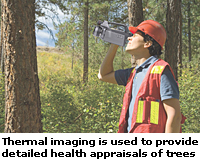Thermal imaging for the structural assessment of trees
10/11/2009
 The need to assess the overall health of trees is a growing requirement in property and environmental management. Contrary to popular belief, the probability of a person being fatally injured by a falling tree is extremely low. The risk per head of population is calculated to be in the region of one in 20 million. Clearly, however, as trees in public spaces grow, their structure needs to be managed to preserve both property and public safety. Facilities managers and local authorities therefore have the task of balancing acceptable risk with the need to maintain tree stocks to enhance the environment and conserve nature.
The need to assess the overall health of trees is a growing requirement in property and environmental management. Contrary to popular belief, the probability of a person being fatally injured by a falling tree is extremely low. The risk per head of population is calculated to be in the region of one in 20 million. Clearly, however, as trees in public spaces grow, their structure needs to be managed to preserve both property and public safety. Facilities managers and local authorities therefore have the task of balancing acceptable risk with the need to maintain tree stocks to enhance the environment and conserve nature.The traditional methods of obtaining information on the health and structural status of a tree, in order to make these management decisions, are time consuming. Generally, the assessment is far from holistic and invasive testing is often required. With these factors in mind, Tree Project Limited, with its origins in Nottingham Trent University, has developed high quality and sustainable tree management systems that are quick, easy and cause no harm to the tree. Furthermore, its techniques are saving its clients significant time and money.
Tree Project Limited uses FLIR thermal imaging equipment for the purpose. As company founder Dr Marcus Bellett-Travers explains: "This technology is ideal as it is the only non-invasive method that can distinguish between living and damaged stem tissues. It is also 100 to 1000 times quicker than other techniques at providing the necessary information. Because it's so fast, it's highly cost effective."
He continues: "We can provide detailed health appraisals of the trunks and branches of up to 100 trees in a single day. And when a localised part of the tree is of interest, such as identifying basal decays in trees, that total can amount to several hundred trees. Also, measurements are made without the need to climb trees or to break through the protective bark layer or reaction zones."
Trees produce very low metabolic energy by comparison to other living organisms. This means most of the heat energy emitted from the surface of the trunk and limbs has previously been absorbed from the environment. Sound, healthy wood has good connectivity and water distribution between cells. This is seen by the FLIR thermal imaging camera as even heat dissipation over the tree's surface.
If the normal function of the wood is disrupted by physical damage or the action of pathogens, the flow of heat is interrupted and cooler areas become apparent; the greater the extent of cooling on an internal volume of wood, the greater the effect on the temperature at the surface.
To create a thermal benchmark database, Tree Project initially imaged 400 trees. Today, that reference library sits at more than 35,000 trees and is subject to continuous updating. Using a comparative image technique that it has now developed, the company is also able to calculate the thickness of healthy wood to show a damaged tree is responding to surgery and treatment.
Tree Projects Limited predominantly uses a FLIR P-Series camera. The company has also invested in a top-of-the-range FLIR B-Series camera. This product is aimed at building diagnosis but is highly appropriate for tree health assessment as it is designed to operate in a smaller temperature band. It is therefore possible to see small temperature variants of 1 – 2°C.
Once images have been captured on the cameras, they are processed using Tree Project's special Tree Thermal Matrix Software, TTMS™, that was created using the Software Developers Kit supplied by FLIR. This allows a percentage of dysfunction to be assigned to a tree and this, in turn, can be used to calibrate probability of failure. Wind loading is subsequently factored in as a further potential contributor to failure based on a five-point scale created using Met Office data. A risk categorisation of low, moderate, high and severe can then be applied to the tree.
FLIR thermal imaging is also being used by Tree Project in a newly developed system of above-ground analysis and partial root excavation to obtain information about the progression of diseases. Combining thermal imaging with careful excavation of distinct parts of the root allows evaluation without damage to the root system. "This technique continues to improve our understanding of how trees interact with the fungi that remove wood through the decay process," Dr Marcus Bellett-Travers continues. "Many of the fungi that were once thought to only damage trees have been shown by this process to have little effect on its performance. In fact, it can actually improve it."
Although the majority of Tree Project clients taking advantage of thermal imaging are in the local authority sector and pursuing a health and safety remit, others focus on the conservation of historic trees. Woburn Abbey, The National Trust and Blenheim Palace are typical examples. Dr Marcus Bellett-Travers concludes: "Thermal imaging is ideal for this type of work as it allows us to pro-actively maintain the health of important tree specimens."
www.flir.com